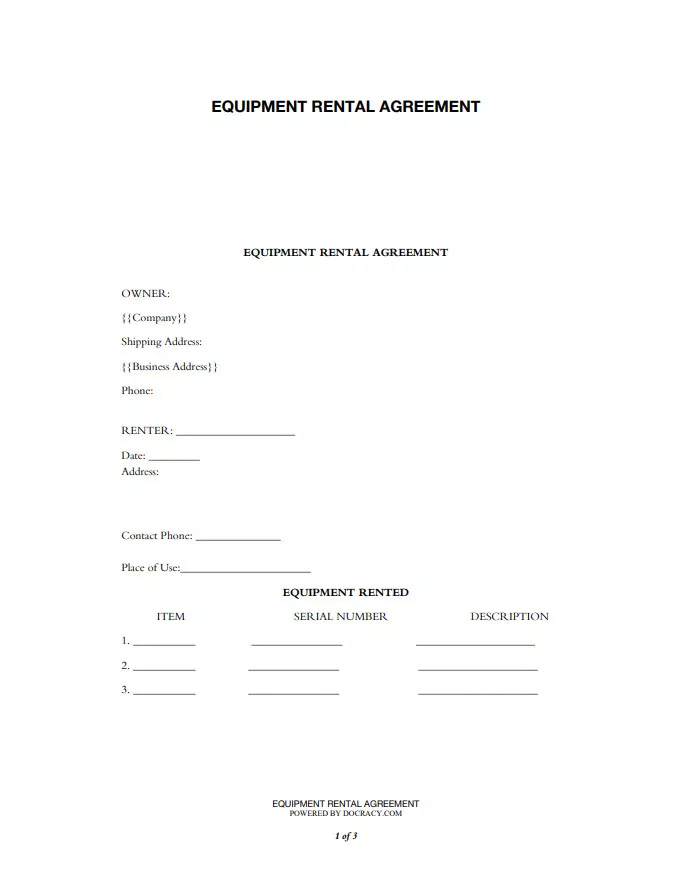If you are planning to rent equipment for personal or business use, having a written agreement can help protect both parties involved. An equipment rental agreement is a legally binding document that outlines the terms and conditions of the rental arrangement. It provides clarity and avoids any potential misunderstandings between the renter and the equipment owner.
This article will discuss the what, why, and how of using an equipment rental agreement, as well as provide examples, tips for success, and more.
What is an Equipment Rental Agreement?
An equipment rental agreement is a document that outlines the terms and conditions of renting equipment. It includes important details such as the names and contact information of both parties, the description of the equipment being rented, the rental period, payment terms, liability and insurance requirements, and any other specific terms agreed upon by both parties.
Having a written agreement helps protect the interests of both the equipment owner and the renter. It ensures that both parties are aware of their rights and responsibilities, and provides a legal framework in case any disputes arise during or after the rental period.
Why Use an Equipment Rental Agreement?
Using an equipment rental agreement offers several benefits:
- Clarity: A written agreement provides clear guidelines and expectations for both parties. It eliminates any ambiguity or misunderstandings that may arise from verbal agreements.
- Legal Protection: A rental agreement is a legally binding document that protects both the equipment owner and the renter. It helps resolve disputes and provides a framework for legal action, if necessary.
- Record Keeping: Having a written agreement serves as a record of the rental transaction. It includes important details such as the rental period, payment terms, and conditions of use, which can be referred to in case of any issues or discrepancies.
- Professionalism: Using a rental agreement shows professionalism and establishes a formal business relationship between the equipment owner and the renter. It sets clear expectations and reinforces the seriousness of the rental arrangement.
Equipment Rental Agreement – How to Create One
Creating an equipment rental agreement is relatively simple. Here is a step-by-step guide on how to create one:
- Gather Information: Collect all the necessary information, such as the names and contact information of both parties, a detailed description of the equipment being rented, the rental period, and any specific terms or conditions.
- Use a Template: Look for an equipment rental agreement template online or use word processing software to create your own. Make sure the template includes all the essential elements, such as the names of the parties, description of the equipment, rental period, payment terms, and liability and insurance requirements.
- Customize the Agreement: Tailor the agreement to your specific needs by adding any additional terms or conditions. Make sure to be clear and specific in your language to avoid any potential misunderstandings.
- Review and Edit: Carefully review the agreement for any errors or inconsistencies. Make sure that all the information is accurate and up-to-date.
- Sign and Date: Both parties should sign and date the agreement to indicate their acceptance of the terms and conditions.
- Distribute Copies: Provide a copy of the agreement to both parties involved in the rental transaction. It is recommended to keep a digital and physical copy for record-keeping purposes.
Example of an Equipment Rental Agreement
Here is an example of an equipment rental agreement:

Tips for Successful Equipment Rentals
Here are some tips to ensure a successful equipment rental experience:
- Research the Equipment: Before renting equipment, research the different options available and choose the one that best suits your needs. Consider factors such as size, capacity, and features.
- Read the Rental Agreement: Carefully read and understand the terms and conditions of the rental agreement before signing. Ask for clarification on any unclear or ambiguous terms.
- Inspect the Equipment: Before accepting the equipment, thoroughly inspect it for any damages or defects. Take photos or videos as evidence of the equipment’s condition.
- Maintain and Clean the Equipment: Follow the instructions provided by the owner for the proper use and maintenance of the equipment. Keep it clean and in good working condition.
- Communicate with the Owner: If you have any questions or concerns during the rental period, communicate with the owner promptly. Addressing issues early can help avoid further complications.
- Return the Equipment on Time: Return the equipment on or before the agreed-upon date to avoid any late fees or penalties. Ensure that it is cleaned and in the same condition as when you received it.
- Review the Rental Experience: After the rental period, provide feedback to the owner about your experience. This can help them improve their services and assist future renters in making informed decisions.
Free Equipment Rental Agreement Template!
An equipment rental agreement is an essential tool for both equipment owners and renters. It provides clarity, legal protection, and a record of the rental transaction. By following the tips mentioned in this article and using a well-crafted rental agreement, you can ensure a successful and hassle-free equipment rental experience.
Equipment Rental Agreement Template – Download